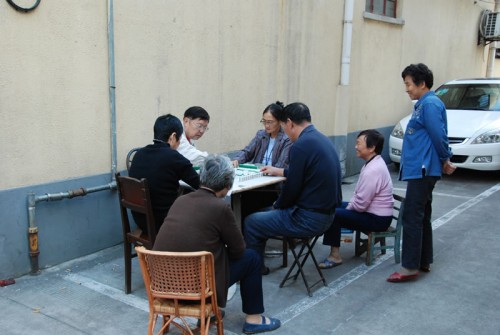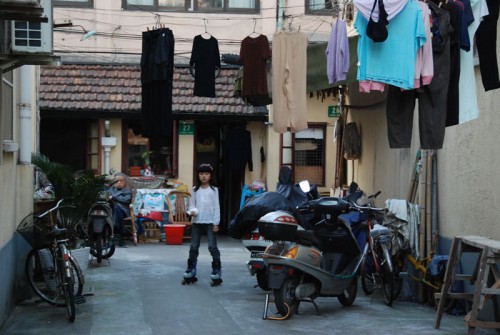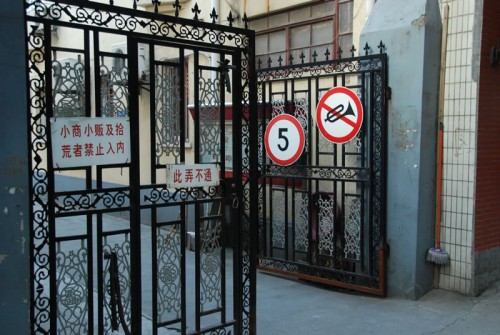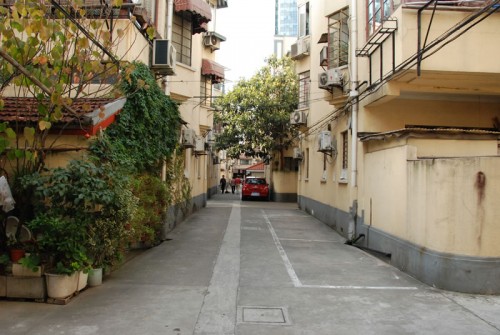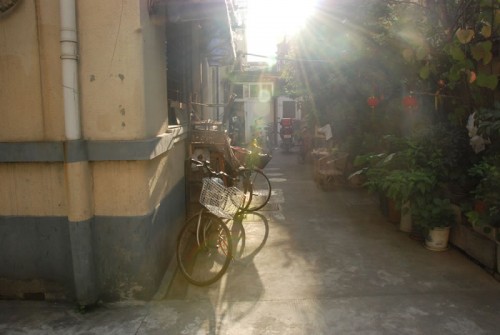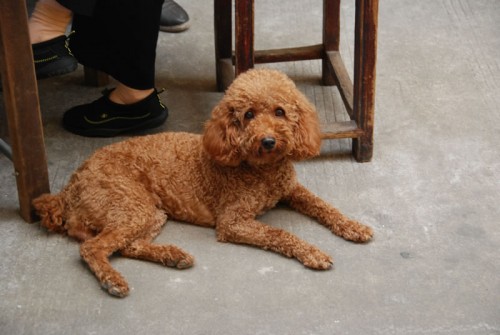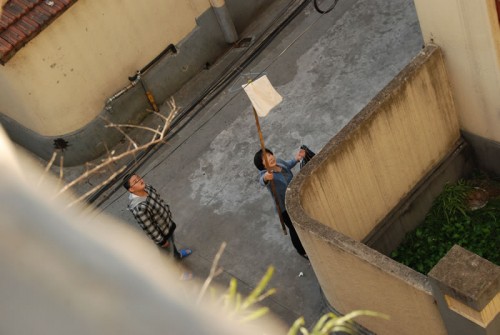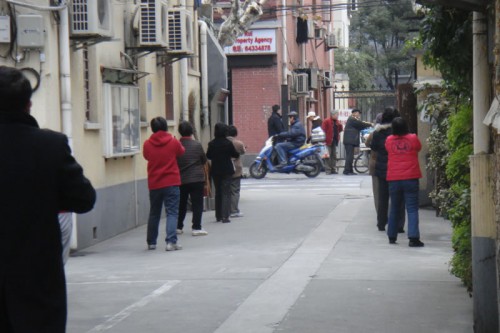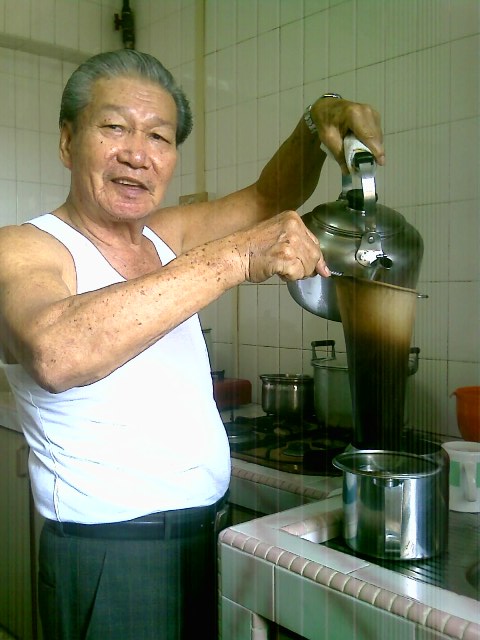MM Lee greeting Deng Xiaoping during the Chinese leader’s visit to Singapore in 1978. Singapore was the only country clearly singled out by China as a model to be emulated in its 30 years of reform.
Posts tagged ‘Singapore’
The ghost of Mao can certainly be divined in China’s current anti-vulgarity campaign, but he may have to take a back seat to capitalist-roaders Chiang Kai-shek and Lee Kuan Yew.
By Jeffrey Wasserstrom
China’s crackdown on vulgarities — like wearing PJs in public — can seem rooted in the Communist campaigns of the era of Mao Zedong, center, but it’s just as likely derived from the Confucian-inspired reigns of Chiang Kai-Shek, left, or Singapore’s Lee Kwan Yew.
“One can imagine Chiang Kai-shek’s ghost wandering around China today nodding in approval, while Mao’s ghost follows behind him, moaning at the destruction of his vision.” — Rana Mitter, Modern China, Oxford University Press, 2008
“The communist leaders of the world’s most populous nation are taking lessons from the small city state of Singapore. …” Asahi Shimbun, China’s Top Officials Study at Singapore’s Knee,” June 2010
For someone who’s been dead almost 35 years, Mao Zedong (1893-1976) has been getting a lot of attention lately.
In 2005, Jung Chang and Jon Halliday’s Mao: The Unknown Story, which presented Mao as a demonic figure, became an international bestseller. It generated enough controversy for Routledge to publish an edited volume last year, titled Was Mao Really a Monster?, made up exclusively of academic responses to it. This year’s crop of English-language Mao publications includes another edited volume, Timothy Cheek’s A Critical Introduction to Mao, plus a pair of accessible but otherwise very different kinds of books by academic historians: Rebecca Karl’s Mao Zedong and China in the Twentieth-Century World: A Concise History and Frank Dikötter’s Mao’s Great Famine: The History of China’s Most Devastating Catastrophe, 1958-1962, a much longer and much darker work.
In part because of this attention, it is hardly surprising that allusions to the lingering influence of Mao’s thoughts and policies crop up routinely in Western news reports. In television coverage of the 2008 Olympics, for example, shots of the giant portrait of Mao were often shown as a shorthand method for reminding viewers that, all the megamalls and McDonalds notwithstanding, the People’s Republic of China was still a country governed by a Communist Party. And a recent Los Angeles Times story about media censorship includes a reference to parallels between the current drive to purge popular culture of the “three vulgarities” (salacious, mindless and tasteless content) and “the elaborately named campaigns extolled by Chairman Mao.” One cheeky Australian writer, who also alluded to Maoist parallels, has suggested President Hu Jintao can now add the title “chief prude” to his CV.
There’s no question that Mao left an indelible mark on China (this may be the only point of agreement among the authors and editor of all the recent books about him), but as the quotations provided above and much recent scholarship suggests, the current consumerist PRC 2.0 should not be viewed solely through the lens of Maoist legacies.
To make sense of the anti-vulgarity drive, as well as the campaign-like aspects of recent mass spectacles, such as the Olympics and the World Expo underway now in Shanghai, it is useful to look back to what two other authoritarian leaders did in their heyday — Chiang Kai-shek (1887-1975) and Lee Kuan Yew (1923- ). Recent Chinese campaigns are similar to those that Chiang launched in the 1930s, when his Nationalist Party controlled the Chinese mainland. They also resemble those that have taken place in the Republic of Singapore, during the years that Lee formally ran that city-state as its first prime minister (1959-1990) and the period since he has retired from office (yet continues to exert a strong influence on the country). And the parallels with Singapore are hardly accidental, since the strategy of its ruling elite — who have found a way to combine one-party rule and rapid development, while stressing the importance of traditional values — has been of great interest to various post-Mao Chinese leaders, beginning with Deng Xiaoping (1904-1997).
A good place to start a comparative look at the influence on contemporary China of the Mao era, the period when Chiang was the authoritarian modernizer running the mainland (1927-1949) and Singapore in the decades shaped by Lee, is with the Olympics.
Several people living in China’s capital in 2008 have told me that they felt as though their city was in the midst of a campaign that year, thanks to such things as the constant repetition of a basic slogan (“One World, One Dream”), the continual exhortations for people to work together to achieve a goal (that of mounting a world-class spectacle), and the media’s effort to change the way people behaved (for example, the calls for an end to public spitting). Mao’s China was defined in part by periodic mass drives, and the mobilization and propaganda associated with the Olympics can be fit into a lineage that goes back to such early PRC events as the “Three Antis” and “Fives Antis” campaigns of the early 1950s.
Campaigns, moreover, have never ceased to be part of the Chinese Communist Party’s political repertoire — though, to borrow a useful distinction from a recent conference paper by Harvard political scientist Elizabeth J. Perry, there’s been a notable shift over time from “mass campaigns” (that could easily spin out of control) to “managed campaigns” (that are more disciplined and top-down in nature).
In many ways, however, as Susan Jakes pointed out in a blog post at the time, the preparations for the Olympics were equally or more reminiscent of the most famous Chinese national campaign of the pre-Mao era, the New Life Movement of Chiang Kai-shek. Beijing in 2008 also had many features that would have seemed familiar to a past resident of Singapore, a metropolis whose 1960s cleanliness and courtesy drives and their sequels earned it the nickname “campaign city” (a catchy phrase, albeit not as catchy as “Disneyland with the Death Penalty,” which sci-fi writer William Gibson used as the title of his 1993 Wired magazine account of the “clean dystopia” of Southeast Asia). To note one specifically, both the New Life Movement and some Singapore campaigns also tried to put an end to public expectoration. More importantly, the Opening Ceremonies of the Olympics, a peak moment in the 2008 Beijing campaign, began with Confucius being quoted and a large contingent of performers dressed as the sage’s disciples taking the stage. Appeals to Confucian values were central to the New Life Movement and are commonly made by Singapore’s leaders, but the only way that Confucius figured in Maoist campaigns was as a vilified figure, blamed for promoting “feudal” values (such as prizing age over youth, men over women, tradition over innovation) that had held China back as a nation and caused great harm to its people.
Having recently spent a month in Shanghai, while the expo was taking place, I can attest that this mega-event is also giving the Chinese city a campaign-like feel. The slogans are different and a new wrinkle has been added to the call for a change in public deportment, with authorities targeting as immoral the tendency of some locals to wear pajamas on the streets of their neighborhoods. Still, there are many similarities with the Beijing case. And once again, New Life and Singapore analogies seem at least as apt as Maoist ones.
The anti-vulgarity drive, though, with its call for all Chinese, and particularly Internet users and popular entertainers, to eschew crass modern forms of entertainment, create art more in line with classical traditions, and value social harmony, provides an even more compelling present-day illustration of the phenomenon under consideration here.
This drive echoes nicely one aspect of the Singapore model, for the country’s ruling elite has long made “social harmony” one of its watchwords and was an early adopter of high-tech strategies for controlling the Internet and guiding popular use of the Web, in ways that resemble what the astute Beijing-based media analyst Jeremy Goldkorn has referred to as China’s “net nanny” system. And while there’s a semantic parallel between the current attack on the “three vulgarities” and campaigns of the 1950s-1970s that included numbers and the word fan (anti), there are features of it that, to borrow Mitter’s imagery, would likely make Chiang’s ghost smile but Mao’s ghost shake his head. In his 1934 speech on “The Essentials of the New Life Movement”, after all, Chiang referred to the damage that “rudeness and vulgarity” and also “social disorder” could do to a nation. This language is very similar to that used by China’s current leaders, who have jettisoned completely the strain of Maoism that insisted on the need to break from all longstanding traditions and valued struggle, not harmony, as the key to progress.
Mao, in the same famous essay which included the memorable line that “revolution is not a dinner party,” mocked the very notion of promoting “refined” forms of behavior. Now, though his successors share his desire to keep a lid on dissent, as shown by the fact that targets of the latest censorship drive have included not just tacky television shows but a famous comedian known for poking fun at officials, they’ve taken a very different approach to topics such as refinement and traditional values.
There’s a cultural conservatism among the leaders of PRC 2.0 that makes them, in some ways, more like the non-Communist authoritarian modernizers of China’s nationalist era and the people running Singapore when William Gibson visited it than they are like Mao, with his penchant for iconoclasm and fondness for campaigns that could, and sometimes all too tragically did, spin wildly out of control.
The longstanding Cold War assumption was that to understand the policies or think about the prospects of one set of Communist Party leaders was to place them analytically beside other past or present heads of Marxist organizations. This is one reason so many people predicted, erroneously, late in the last century that the Chinese Communist Party was certain to lose it grip on power in the same way that its Central and Eastern European counterparts had in 1989 and their Soviet ones had in 1991. The analysis provided here, which presents Hu Jintao and company as sharing important traits with not just Communist leaders of the past but also figures such as Chiang and Lee, will not tell us what will happen next in the protean PRC 2.0. It can, though, do a bit to help us shed some useless Cold War baggage and protect ourselves from falling into the trap of assuming that China’s political future must lead in any given direction.
via
http://www.miller-mccune.com/politics/three-ways-of-looking-at-the-prcs-latest-campaigns-22799/
I had just seen Gary Hustwit’s Urbanized, and I must say one of the quotes from the documentary hit the nail on the head about Singapore’s social condition. I’ve always felt there was a problem with the communal landscape in Singapore - the problem that there was none. But I accepted it as being part of an ‘advanced’ and ‘modern’ society, that we were modern citizens of a city, and not some village or town in some rural area. I grew up in Toa Payoh in Singapore, the first and oldest area to have HDB flats built. HDB flats, as they are known in Singapore, are government-built residential blocks varying from 20-10 stories high which provide an affordable and comfortable housing solution to most residents in Singapore. They are an architectural model based on Bauhaus concepts, using modular blocks stacked on top of each other like Lego. Yes, they were based on famous Bauhaus ideals of design that followed function and social responsibility. But yet, as we know, design that arises from rational motivations will only have rational results, and tends to be a little cold.
No I’m not criticizing the government housing in Singapore, but yet I am. I have first-hand experience of what it feels like, growing up 21 years in a HDB neighbourhood. Yes, it is a great solution. Being a small island, it solves the problem of space, becoming a vertical street that floats in the air, and being modular, it can be cheaply fabricated and duplicated, again and again, and again and again. This provides affordable housing for everyone, a privilege that Singaporeans do not understand how lucky they are to have. If they ever traveled elsewhere, such as China or even the States, they will realize it isn’t as convenient elsewhere. So I’m grateful for what it is and its purposes. But here I have to stop my praises and be critical for what it is, for I am a child of my land, and one can’t help but point out the consequences of such a model.
The quote in Urbanized showed a building in New York, probably built during the time of Robert Moses, not unlike the HDB flats in Singapore, and remarked that such buildings destroyed the framework of a community, because it prohibited interaction between the neighbours. In traditional times when we still had villages or towns, when everything was more or less flat, people could see what was outside their house, and would sit outside too. There were open spaces where children could play, and people are rather visual; they associate with what they see, and over time, they recognize neighbours, they start chatting and everyone becomes a community. Such is lost in the modern high-rise. Nowadays, residential blocks are cold and inhumane, filled with dark corners that people are afraid to go to. Few talk to each other, because the balconies are so narrow, and for some reason, people feel like trouble is looking for you when strangers knock on your door. There is no more public space near the living areas save for the playgrounds downstairs. And even so, space is wasted because the journey along the balconies and vertically through the lifts have become purely functional for getting from point A to point B, whereas back in the day, the journey home is also the journey to greet and interact with the community. The points of interaction in HDB heartlands in Singapore now are only in shopping malls, churches, playgrounds (which are usually deserted now), coffee shops (known as kopitiams) and schools. Other than these touchpoints, the residential areas are basically stark and provide only a singular function: for you to rest at home with your family. Hence I have grown up without knowing most of my neighbours, although luckily for me, we were at the unit beside the elevator, and people always had to walk past our door to get there, so they would sometimes say hello. I knew most of the shopkeepers downstairs my block, and even after 7 years of absence, they would still give me a smile or a nod when they see my face on my visits back home. That was the little warmth I could get out of communal living, but it’s even colder now as most HDB flats don’t have shops at the base but only cold empty void decks. This is why you have an international community in Singapore, with multi-cultures and multi-races living in the same block and on the same street, but yet no sense of community in the residential areas, and hence no sense of belonging. You do, however, feel a sense of belonging to organizations and institutions such as schools and workplaces.
I have been in and out of Shanghai, but in the past year I have moved into an old lane house in the French Concession. The old lane houses in Shanghai are called ‘Nongtang’ (弄堂), which are really small lanes that extend from the main road into an area of low-storied houses. These clusters of houses are grouped by a unit number, such as 12′Nong’, and they have a gate and a security guard assigned to each Nong. Inside each Nong there is a a common rubbish area, in some Nongs there are common bath houses and common washrooms. The area inside each Nong is lively, because they understand that the people who live within the gates are all neighbours, and so they put out their stuff freely, hanging clothes and plants. They also tend to take out their chairs in Summer, the old people mostly, sit around and chat or play mahjong in the sun or at night, or letting their dogs play with each other. Even though I have only lived here for a year, I already start to recognize most of their faces since I get to see them more than I did back in my HDB flat in Toa Payoh, and for them mine. There is a sense of looking out for each other within each Nong, as some thieves tried to steal my bike before, and my neighbour’s dog barked and another neighbour also caught someone suspicious in the area and saved my bike. Once, an old lady’s son came to knock on her door but no one answered even though he could hear the TV from outside, and he was worried that the worst might have happened, and so started banging away at the door for her to open up. It was late at night and it stirred the entire Nong, who all came out to find out what’s happening and if they could help, which they did. My neighbour downstairs, who is an old ayi, took a long bamboo stick and started knocking on that lady’s window. Fortunately the old lady woke up and opened the door, and everyone had a sense of relief. I would never have had such an experience in Singapore. Nothing so human.
What does all this mean and what am I saying? I just feel that if Singapore wants to create a communal society, where people look out for each other and are not just selfish and think about themselves, and where people feel like they belong to where they live, then something ought to be changed. The interaction between residents needs to be facilitated through urban planning and design, even in the details at the very bottom level, like the mailboxes. Could we humanize them? Instead of just numbers, could we have a blank where people could write their family names or welcome messages or even draw pictures? There is a stark contrast between living in Singapore and anywhere else, and it is the lack of humanity. Do we really need void decks? At the end of the day, they become spaces for people to park their bikes or for kids to play soccer, which aren’t that bad, but weren’t the point of them to begin with. Their ‘repurpose’ came from the people living there themselves, finding use in a space that was left wasted. Quite often now, soccer is even banned from those void decks in fear of hurting someone. Everything in Singapore is duly organized, sectioned off piece by piece, in their places where ‘they should be’. If you want to do sports, take it to the stadium or the community centre. If you want to buy something, go to the centralized malls. Life is separated into compartments, with gaps in between; gaps that are wasted and lifeless, but worst of all, gaps that make residential life disconnected. Why can’t we have a cafe in the void decks? Or a late night movie screening where everyone is invited? Why can’t the walkways between school and HDB flats be filled with small little stalls or shops or games? It’s almost more interesting if you are forced to walk through something to get to another place, because it forces interaction and people are aware of their surroundings. What if you had to walk through a flea market or a bunch of people pracitising taichi everytime you want to get home? Wouldn’t that be more interesting?
In my place in Shanghai, because these old houses used to be a single unit, but were split up into 3 units after the war, I have to walk through my neighbour’s kitchen everytime I want to get home ( I live on the third floor). At first I thought it was annoying, but then I realized how interesting it is as I had to walk through their home everytime, and I would greet the old ayi and her family and her dog everytime I came home. And they would greet me back too.
I never got this in Singapore. And I had lived in the same place for 21 years.
I underline the government’s determination that nobody should use dialects. Indeed wise parents will never let their children speak dialect at all . . . The more one learns dialect words, the less space there is for Mandarin words or English words, or multiplication tables or formulas in mathematics, physics or chemistry.
- (Speech on ‘Mandarin must replace dialects as the mother tongue’ on 25 October 1981, by Singapore’s Prime Minister Lee Kuan Yew, Singapore Chinese Chamber of Commerce 1991)
According to the Government, Singapore’s lack of progress, particularly amongst the Chinese Community, was largely due to the use of dialects creating an incoherent and divided society. To tackle the problem, the Government introduced the Speak Mandarin Campaign (SMC) in 1979, which effectively signalled the beginning of the death of dialects.
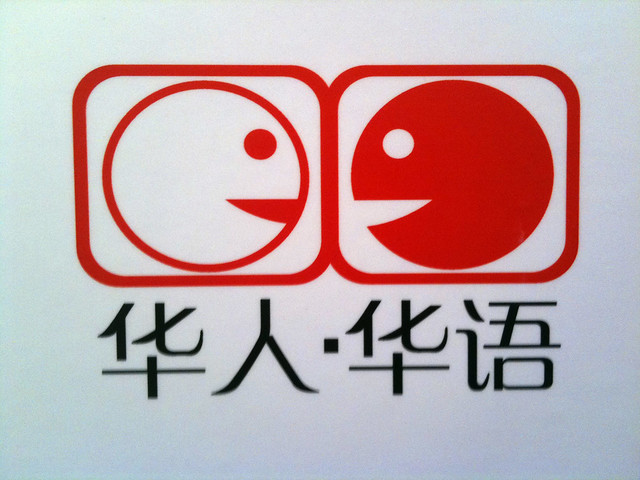
One of the many Speak Mandarin Campaign slogans
THE BEGINNINGS
Singapore’s many Chinese dialects (Hokkien, Cantonese, Hakka etc.) came about as a result of early settlers arriving from various provinces in China.
In the 1950s & 60s, Singapore, like many de-colonised countries, began a search for an independent national identity. The Chinese in particular, turned to the cultural products of film and music from Hong Kong as a source of inspiration. The fascination with Hong Kong was also seen as a reactionary and feudal ‘Yellow Culture’ that was set out to oppose the ‘Red’ culture still apparent in Communist China.
Canto-pop in particular, boomed because of its apparent lack of censorship and ‘sexy songstress’, and made its way to the hearts of Singapore with popular Hong Kong singers taking centrestage at the Republic’s newly established culture centre, the National Theatre.

Cantopop made its presence felt in Singapore even before the Four Heavenly Kings.
THE GOVERNMENT STEPS IN
However, Singapore’s continued emphasis of bilingualism upon independence was becoming more apparent in both schools and the media, and this led to ‘actively discouraging’ the use of dialects championed through the Speak Mandarin Campaign, with then PM Lee going as far to say that ‘ Chinese Singaporeans below the age of forty who speak dialect will the last in queue (in government departments)
Some slogans throughout the years of the Speak Mandarin Campaign include
华人讲华语,合情又合理 (Mandarin’s In. Dialect’s Out – 1983) and
常讲华语,自然流利 (More Mandarin, Less Dialect. Make it a way of life – 1989)
Some of the first steps on the emphasis on Mandarin by the Government included the removal of popular Cantonese programmes from television and radio stations, most of which were state owned. By 1981, they were phased out, much to the displeasure of even non-Cantonese Singaporeans.
Even up till today, the Media Development Authority(MDA), states that on National Television, ‘All Chinese programmes, except operas or other programmes specifically approved by the Authority, must be in Mandarin. Dialects in dialogues and songs may be allowed provided the context justifies usage and is sparingly used.
None of this is more perhaps more apparent in the movie Army Daze, where Malcolm and gang frequently tell the hokkien spewing character Ah Beng to ‘讲华语‘ (speak Mandarin).
DIALECTS WELCOMED BACK?
Dialects however received some reprieve in 1991 when the PAP lost four constituencies during the General Elections. One of the reasons cited for poor results being the use of dialects by Opposition leaders reaching out to the Chinese voters.
Many also saw the Speak Mandarin Campaign as a propaganda effort to alienate a large section of the working-ethnic Chinese who still predominantly spoke in Dialects.
The Government then stepped it and although they never actively promoted the use of dialects, they stopped shoft of discouraging it and even allowed TVB, the Hong Kong Cantonese station to be shown on cable television in 1995.
Even the Prime Minister himself has been seen using dialects phrases in many National Day Rallies, none perhaps more famous than his statement one should order mee siam mai hum.
The effects of the Speak Mandarin Campaign were however already evident, with the population of households now increasingly using less dialects and more Mandarin.
|
Language Spoken at Home Among Chinese Resident Population in Singapore[30] |
|||||
|
Predominant Household Language |
1957 (%) |
1980 (%) |
2000 (%) |
||
| English | 1.8 | 11.6 | 23 | ||
| Mandarin | 0.1 | 10.2 | 35 | ||
| Chinese Dialects | 97 | 81.4 | 30.7 | ||
THE IMPORTANCE OF DIALECTS
Dialects however represent a truly cultural link and experience for many, the deterioration of which has led to a comprehensive lack of communication between the elderly and their grandchildren.
The beauty about dialects, just like any other language, is that it is able to emote a certain feeling through it words that no dubbing or subtitling is able to accomplish.
It also surprising that the Government, with its constant strive for racial harmony, actually saw the Speak Mandarin Campaign as a way to improve cohesion in the community and not a tool for economic progress and trade relations with the increasing power that was China.
Nothing really beats walking into a dim sum restaurant and hearing the waiters shout to each other in Cantonese, trying to understand what your grandparents say, or simply even telling the coffeeshop uncle that all you want is a nice cup of ‘teh siu dai (tea with milk but less sugar). Dialects should be here to stay and is one of the few things we should not let any form of education or state run campaigns intervene in.
